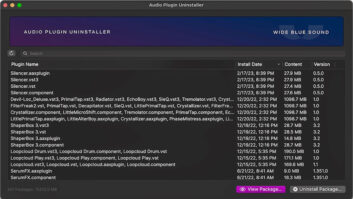DGA president/film director Taylor Hackford
Photo: Mel Lambert|content-creators.comBy Mel Lambert|content-creators.com

“Piracy is the most threatening risk to have ever hit our industry,” stated Directors Guild of America president Taylor Hackford during his Creative Keynote at the Entertainment Content Protection Summit in Universal City, CA on December 8, 2010. “No business model we can develop will compete with free. Why would [content companies] risk money if they cannot get their investment back?”
The one-day conference, co-organized by Variety and the Content Delivery & Storage Association/CDSA, investigated the evolving landscape of content piracy and reviewed a number of business strategies that can be implemented to protect valuable entertainment assets.
In 2004, Hackford explained to Variety’s deputy editor Ted Johnson, “I discovered DVDs of my film Ray being sold on New York’s Canal Street the same day it opened in movie theaters, followed by files being downloaded in 62 countries within two weeks.” Since then, piracy has grown exponentially, the director stated. “We are losing $25 billion a year within the US to theft,” he stated. “Internet theft is now a problem facing all filmmakers, no matter how small or large the film. Everybody from secretaries and craft services to directors and producers must do something about piracy – or we will go out of business.” Hackford was nominated for an Academy Award for directing Ray, and has directed/produced such films as Love Ranch, Proof of Life, The Devil’s Advocate, Dolores Clairborne and An Officer And A Gentleman.
As DGA president, Hackford is committed to protecting the intellectual property rights of its 14,000 members within the film, TV and content-creation industry. “The [DGA’s] top public policy priority is addressing the problem of digital theft. Currently, there are no penalties for selling illegal content on-line,” he said, citing a pressing need for tough legislation that would criminalize the illegal downloading of files and provide rigorous enforcement.
The growth of streaming pirate sites and cyberlockers that offer unauthorized TV shows and motion pictures has been meteoric. According to an independent measurement service, between July and August, there was a 42 percent increase in the number of illegal sites offering on-line streaming, some of which even offer reviews and recommendations.
Michael Ayers, SVP/General Counsel, Verance
Photo: Mel Lambert|content-creators.comOther sessions during the well-attended conference addressed specific ways in which the film, gaming, music and software industries can halt unauthorized theft. Reported attendance was 245 individuals from the content creation and delivery industries “The entertainment industry’s treasure – its content – is being plundered by pirates of all kinds,” said conference co-chair Richard Atkinson from Anti-piracy Worldwide, and former head of Walt Disney Studios’ piracy-prevention team. Rather that rely solely on technology, anti-piracy measures must become part of the creative process. “Our key strategy needs to focus on risk management; piracy is demand-driven,” he considered.

Stuart McClure from McAfee stated during his Technical Keynote that malware attacks have increased exponentially during the past decade. “In 2009, we saw more [computer and website intrusions] than in all of the previous years combined,” he told the conference. “We continuously track the thousands of small teams that create malicious software and system hacks. Consumerization will force more IT changes over the next 10 years than any other trend,” he said citing the accelerating popularity of iPads, smart phones and similar devices.
Moderated by Tom Moran from Savvis, The Content Security: Example Approaches That Are Working session considered various examples of supply-chain management, including new security schemes developed by CDSA for certified suppliers of optical media, including Sony Music Italy, for protecting CD releases. Applying Effective Content Security Approaches to the Evolving and Increasingly Diverse Supply Chains, moderated by Rajan Samtani, focused on techniques for protecting assets. “Do not overlook the human factor,” offered Joe Bigley from Deluxe Digital Studios, which delivers media for a number of films studios and post facilities. “Make employees a part of your security landscape, and explain the value proposition of security policies.”
Steve Weinstein from MovieLabs moderated Defense to Offense: Leveraging Piracy Consumption to Make Money, which looked at forensic watermark techniques to uniquely identify the origin of pirated media, while Advances in Content Protection & Rights Management, moderated by Brad Hunt from Digital Media Directions, considered watermarking that prevents playback of pirated optical media and data files, including a number of solutions from Fortium.
Marcus Cohen, Counsel, Western Region, RIAA
Photo: Mel Lambert|content-creators.comMichael Ayers, SVP and General Counsel for Verance, described the Cinavia audio watermarking used to enable copy management within AACS-protected Blu-ray Disc players. Mitch Singer from Sony Pictures Entertainment detailed the UltraViolet series of DRM solutions from Digital Entertainment Content Ecosystem that allow legitimate owners of content to access both digital and physical media across multiple formats and devices via a cloud-based account; currently, UltraViolet-controlled content is being supported by Comcast, Microsoft, Best Buy and others.

In the final session, The Role of the Industry Organization, moderated by conference co-chair Atkinson, representatives from AFTRA, RIAA, MPAA and Entertainment Software Association/ESA discussed ways in which cooperative activities between such entities can implement wider-reaching strategies. “Movies, games, music and software are major revenue sources, “considered MPAA’s Mike Robinson.
“Since piracy has a major economic impact we need to engage the federal government,” to ensure consistent and enforceable solutions. “We need to find areas of commonality,” concluded Marcus Cohen, Counsel, Western Region for the RIAA, “and respond to our memberships’ needs. We have to deliver the results they need.”
Mel Lambert has been intimately involved with the international AV production industry for more years than he cares to remember. He is principal of Content-Creators.com, a Los Angeles-based consulting service.







